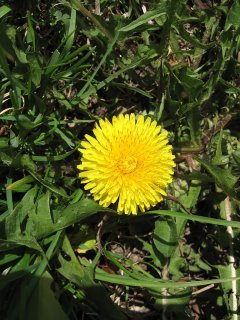Watering can be the single most make or break of gardening. Improper water whether too much, too little or at the wrong time can spell disaster. So here are some of my watering tips most of them learned through trial and error. They are by no means perfect and you will have to adapt to your situation.
Timing:
I prefer to water in the early morning before the full force of the sun hits the plants. Water acts as a magnifyer to the sun's rays causing sun burn on the plants. Watering in the morning also helps them get through the heat of the day. The only time I water during the heat of the day is if I see a plant in distress. Most times this is a container plant that dried out too quickly. Then I hand water the soil not the plant. I have watered in the early evening after a very hot day to give my plants a little pick-me-up but I'm always sure to water early enough that any wet foliage is dry before nightfall. Sometimes raised beds just like containers need a little extra water. Watering at night without time for the foliage to dry encourages mold and fungus. Wet soil encourages snails and slugs.
Amount:
I think this is one of the critical points to watering. Make sure you water enough but not too much! A brief spraying isn't going to do any good. It will create demanding plants with shallow roots. Too much water will create water logged soil and unhappy plants dying from root rot. So you need a happy medium. In general water once a day but only if needed. Soak the soil well but don't oversoak. For containers that means soak until water runs out the drain hole then stop. My rule with my raised beds is when I see small puddles I know that is enough water. You really have to dig into the ground to see how far the water has penetrated to determine how much to water with raised beds but once you've watered them a few times you will instinctively know. A rain guage is handy when watering raised beds. Watering both raised beds and containers are different than watering traditional in the ground gardens because the soil is controlled but the principles are the same. My neighbour has a large in ground vegetable garden. He handwaters if necessary but seldom uses the hose and never a sprinkler. Basically he let nature take its course. Then he complains his garden doesn't do well. OTHO, I have over producing raised beds watered regularly but not always daily depending on the weather.
Weather:
Sorry but if you are going to garden you need to pay attention to the weather. That means learning to read the skies and keeping in tune with your local conditions. I have found true the the sailors warning is true and being a boater I heed that warning, there is no point watering my garden if the sky is red in the morning. If the night is clear and there is a ring around the moon, don't water because rain is coming! If the leaves on your trees especially maple are turning over, don't water because it is going to rain. I can smell when it is going to rain because of increased ozone in the air but some can't pick up on this smell. My bones ache when it's going to rain too so that is another sign. In our high tech days, sometimes we fail to notice these signs. As gardeners check your weather report and planting guide daily but also learn some of the old ways to help you with your watering needs.
Water:
We are under water restrictions here allowing for watering every other day. I devised rain barrels to help with the watering if needed. We live on the water so we could always cart water to the gardens but that is rather a pain as would pumping water to the gardens. Rain barrels are inexpensive and easy to set up. Get a 50 gal plastic drum and remove the lid. Add a spiggot with hose attachment near the bottom if desired (preferrable). Test you spiggot for leaks "before" continuing. Turn the barrel right side up and attach window screen to the top of the barrel. This will keep debris and leaves out of your barrel. Place your barrel near your downspout. Cut downspout and/or redirect into the centre of the barrel. Wrap chicken wire around the barrel and secure. Now, push the barrel into place. The downspout should be in the centre of the barrel. Plant vining plants of your choice such as ivy or clematis around the base of the barrel. These will grow up the chicken wire masking the barrel. When your barrel gets about half full, add feeder goldfish or ruby red minnows to control mosquitoes. Now you have an inexpensive but visually appealing water barrel to help your watering needs. There are two ways to use your barrel. Hook up a soaker hose or hand water. If you have access to a natural source of water which we do you can either cart water or hook up a pumping system if allowed. Some municipalities will not allow you to do this but most will. If you can it will provide a nutrient rich souch of water hopefully chemical freee. At any rate any type of water souce for your garden should be used to its full potential without wastage. Municipal water is easier to use but conservation is still necessary. In most cases there is a charge for municipal water.
Methods:
This is by far the largest area to differ on. I like easy methods that don't waste water and for that reason I "prefer" soaker hoses. They can be concealed by mulch or ground cover. Once in place they only need to be hooked up and used with draining in the winter if you are in an area that freezes in winter. No muss, no fuss and easily adaptable to the water barrel. They best part is of all watering methods they put the water where it is needed and reduce evapouration and wastage. Second to that I use hand watering for the vegetable gardens consisting of a multi-sprayer set to shower. In the greenhouse I use the mist or shower setting but my son is experimenting with a drip system so that might be changing very soon.
Hand watering by watering can works well too. It is more time consuming but can be a great diversion for a restless young one :) I still very much enjoy watering this way. My neighbour still does it this way the majority of the time.
Sprinklers waste a lot of water through evapouration, large coverage area and they soak the foliage creating problems you don't want such as mold and fungus especially if used in the evening. There is a tendency to overwater because you walk away then forget the sprinkler is on. The problem is they are a cheap and easy solution for the novice gardener. So most of us have at one time used them and some of us still do. I think a rain guage is important when using a sprinkler. Water to your desired amount in the guage then turn the sprinkler off. While a sprinkler is an easy solution, try to use it only when necessary.
Containers present their own problems because they can dry out so fast. I use the shower setting with the hose but have come up with a couple of other ideas. I'm testing my sons drip system on a couple of plants so if that goes well I'll post the instructions. So far so good. I use the wick method on other container plants. Simply take a plastic container like a sour cream container. Fill with water. Poke a hole in the top and tread synthetic wick through it long enough to reach the bottom of the container. Put the lid on the container. Push wick up through the drain hole of the pot to near the surface. Set pot of reservoir (plastic container) and the plant will water itself for about a week. Use larger reservoirs for larger containers.
Miscellaneous:
While you are considering water, add a water feature or a couple of bird baths. You want to encourage birds, butterflies, and bats into your garden. They all need water. There are several ways of doing this of which I won't go into detail now. Keep your bird baths clean. Change the water daily! Add the sounds of water flowing buy using a smal recirculating pump and air tubing to create a fountain or bubbling water. Birds are drawn to the sounds of tinkling water. The sound is rather pleasant while you pull weeds in the garden :)
Happy Gardening
Garden Gnome



 Dandelion
Dandelion Greenhouse
Greenhouse Rocking Chair
Rocking Chair Step Ladder
Step Ladder Beds # 1 - 4
Beds # 1 - 4 Beds #1, 3 and 5
Beds #1, 3 and 5 Bed #1 and 5
Bed #1 and 5 Toad
Toad Goldfinches
Goldfinches Tundra Swan
Tundra Swan SFG beds
SFG beds Greenhouse at Night
Greenhouse at Night Sunrise on the Greenhouse
Sunrise on the Greenhouse Sweet Basil
Sweet Basil Tulips
Tulips















